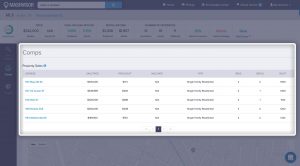Making money in real estate is only possible if it is the right property in the right location. To find this real estate investment, you need to conduct various types of analysis. Comparative market analysis is just one type that you’ll have to carry out as a beginner real estate investor buying an investment property.
Comparative Market Analysis Tool: The Basics
Comparative market analysis (CMA), also referred to as real estate market analysis, is a process whereby the value of an investment property is determined by comparing it to other similar investment properties that were sold recently in the same housing market or location. The property value is determined based on market research, using a range of real estate comps.
Whether you are buying or selling an income property, comparative market analysis tools can be useful in finding out how much it is worth. Knowing property value is important to sellers since it helps them ensure that they don’t price an income property too high or too low. If the price is too high, they might not find a buyer while if it is too low, they might miss out on a good return on investment. For buyer’s, knowing an investment property’s value will help them avoid overpaying and missing out on better investments.
Every real estate investor should have a good understanding of comparative market analysis and comparative market analysis tools. Use of the traditional method in conducting comparative market analysis can be a long and tedious process. However, with the help of comparative market analysis tools, the process can be accurately completed within a few minutes. Here are some of the best comparative market analysis tools for a beginner real estate investor:
1. Investment Property Calculator
The first real step of a CMA is investment property analysis. Naturally, before finding similar investment properties, you need to know all the details about the income property of your choice. You’ll want to find both the qualitative (bedrooms, bathrooms, square footage, etc.) and the quantitative factors (cash on cash return, cap rate, etc.). The real estate listing should have the qualitative factors but you’ll need a real estate tool to find the rest.
There are several real estate metrics that investors need to have to properly analyze investment properties. These metrics help to find the potential of a property in terms of generating positive cash flow and high returns. Performing a thorough investment property analysis will help you find all the necessary values. Note that investment property analysis needs to be performed on your target income property and real estate comps for the most accurate results.
Collection of real estate data and analysis of different properties in different housing markets is a lot of work. It will definitely take a lot of your time, money and energy. One of the best comparative market analysis tools that will help you with this task is Mashvisor’s investment property calculator. This real estate investment tool helps a real estate investor find investment properties that have good cash on cash return, cap rate, rental income, and even estimates the rental expenses for you.
In terms of CMA, the investment property calculator provides ready-to-go real estate comps for every property listing on the platform. So rather than going through investment properties for sale manually and adding them to an endless analysis spreadsheet, you get all of this information at the click of a button.
To start your 14-day free trial with Mashvisor and subscribe to our services with a 20% discount after, click here.
2. A Real Estate Agent
Finding and analyzing investment properties can be bumpy for beginner investors. That is why it makes sense to seek the help of a qualified professional who can guide you. A good real estate agent can perform numerous roles in the purchase of an investment property. They will take the time to understand what you need, your preferences, and budget. They will then help you narrow down your search to find the right investment property at the right price.
A real estate agent is one of the best comparative market analysis tools you need to have. An experienced real estate agent will perform a thorough CMA if you don’t wish to use the tools to do it yourself. He/she will provide you with data on the local housing market and comparable sales. This could include detailed information about property prices, demographics, current market conditions, infrastructure, amenities, and crime statistics. They can help you compare and pick the right property for you.
It is important to find a professional real estate agent that you trust and whom you feel comfortable working with. Mashvisor can help you easily and quickly connect with real estate agents in your target market all over the United States. You simply have to select the real estate market of your choice and find experienced real estate agents to help you in comparative market analysis.
Or you could book an appointment and our team can help you get connected with a real estate agent.
The Bottom Line
Real estate investing is a very competitive business. Successful real estate investors are those that use the best comparative market analysis tools. With these tools, anyone can quickly perform a comparative market analysis to find the best performing investment properties in the best locations.
